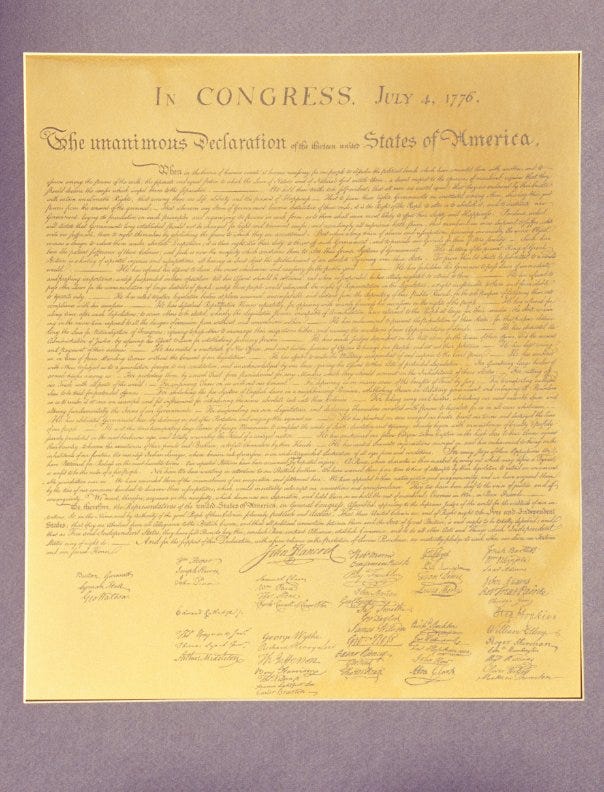What Does the Declaration of Independence Mean Today?
Definitely not the “original” meaning
Issue #79 American History (About 4 minutes reading time)
We hold these truths to be self-evident, that all men are created equal, that they are endowed by their Creator with certain unalienable rights, that among these are life, liberty, and the pursuit of happiness. That, to secure these rights, governments are instituted among men, deriving their just powers from the consent of the governed. That, whenever any form of government becomes destructive of these ends, it is the right of the people to alter or to abolish it, and to institute new government, laying its foundation on such principles, and organizing its powers in such form, as to them shall seem most likely to effect their safety and happiness.
Most of us know this part of the Declaration of Independence, but did you know that the full text of the document includes six long paragraphs of explanation and conclusion, and also twenty-seven individual grievances against the king? You can view the entire text here.
The Declaration of Independence did not apply to everyone, so why should we celebrate?
These days, especially because of recent decisions by the Supreme Court of the United States, including taking away a constitutional right for the first time in American History (Roe v Wade), many people are wondering why they should celebrate Independence Day or July 4th at all.
But Black people, in particular, have been questioning the relevance of July 4th at least since Frederick Douglass made his famous speech, “What Is July 4th to the Slave” on July 5, 1852.
Other forgotten or hidden facts:
All 56 signers of the Declaration of Independence were white men, and 41 of them owned slaves.
The “ideal” of the Declaration was that “all men are created equal,” but “all men” meant all white landowning men. “Equal” did not apply to women, Black or brown people, Asian people, or Native people.
On July 4, only nine colonies voted in favor of adopting the Declaration of Independence. Pennsylvania and South Carolina voted “No,” Delaware was undecided, and New York abstained.
Britain was ending slavery, but most of the colonies wanted the slave trade to continue; another reason they wanted to separate from Britain.
Thomas Jefferson, who was the primary but not the only writer of the Declaration, believed that Blacks and whites could not co-exist in the American nation. He, James Madison, and James Monroe supported the American Colonization Society, which was a campaign advocating that Africans, enslaved and free, voluntarily migrate back to Africa. That would help ensure that the United States of America in 1776 would be for some white men only.
It took the 13th Amendment (ratified in 1865) and the 14th Amendment (ratified in 1868) to end slavery and bestow full citizenship to Black men. These amendments did not give Black men the right to vote; each state was allowed to make its own voting requirements.
Even though the 15th Amendment gave Black men the right to vote, Black men and women did not achieve full voting rights until the Voting Rights Act of 1965.
It took the 19th Amendment (ratified in 1920) to give women full citizenship.
On June 2, 1924, Congress enacted the Indian Citizenship Act, which granted citizenship to all Native Americans born in the U.S. The right to vote, however, was governed by state law; until 1957, some states barred Native Americans from voting. Even now, many states are making it harder for Native Americans who still live on reservations to vote. You can find out more about voter suppression against Native Americans at this link.
Access to American citizenship and voting rights was not available to Asians and Asian Americans until the Immigration and Nationality Acts of 1952 and 1965. These acts removed race as a barrier to immigration and citizenship, effectively ending two centuries of restrictions and legal disenfranchisement.
The Three Main Points of the Declaration of Independence
Some people in America have designated themselves as the only true “patriots” in this country, and they take their clues only from the parts of the Declaration of Independence that they feel advance their cause.
However, it is up to all of us who are Americans to ensure that the primary goals of the Declaration will apply to all of us, no matter how long it takes.
It is also important to remember that the primary audiences of the Declaration were King George III, the American colonists, and potential foreign allies.
It has been 246 years since the Declaration was put into place, and we are nowhere near realizing the stated ideals outlined in the document.
As you read the five main points of the Declaration, think about how each one has not been realized for all of us, and also how we can make each point apply to all of us.
Only then will we really have something to celebrate on July 4th.
Point 1: People have certain Inalienable Rights including Life, Liberty, and the Pursuit of Happiness.
Point 2: All Men are created equal.
Point 3: Citizens have a civic duty to defend these rights for themselves and others because the government comes from the people.
What we can do now
The necessity for the Declaration was years in the making and was primarily protesting against the authoritarian rule of King George III. We must now “rebel” against the minority forces that are attempting to develop authoritarian rule over the majority of us.
Remind people that “life, liberty, and the pursuit of happiness” applies to all of us, not just the people and policies that some of us agree with.
VOTE in high enough numbers in the midterms to ensure that our voices are heard and counted, and that we have true majorities in the House and Senate that will allow things to actually get done.


